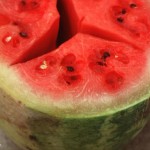Causal Agent(s): (fungi ‑ several species)
The fruit decays at the area in contact with soil. The rot begins as a small water soaked area that quickly spreads. In many cases, the area will be surrounded by a profuse growth of white mycelium. One of the fungal species associated with belly rot is Pythium aphanidermatum (Image 1), which rapidly colonizes the fruit (Image 2). Another species involved is the southern blight fungus, Sclerotium rolfsii, which produces seed-like resting structures (Image 3). The disease is most severe during periods of rainfall and high temperature, when the soil remains wet for long periods of time. To control, use well-drained soils, or plant on plastic mulch.



